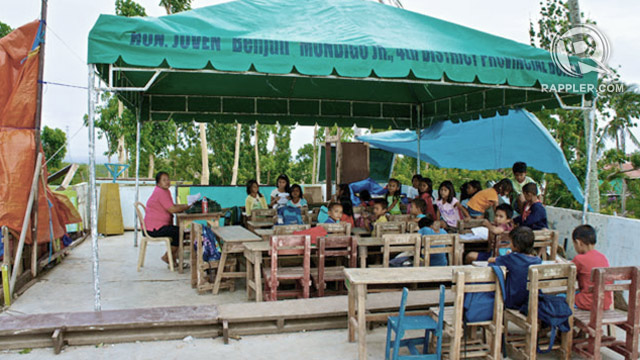SUMMARY
This is AI generated summarization, which may have errors. For context, always refer to the full article.

CEBU, Philippines – It was raining and the kids were outside waiting for my van to arrive. They were expecting me.
They ran outside the gate as the van entered what was left of their school. Open tents first caught my attention. One tent stood as what seemed to be a kindergarten classroom. Another, on the other side, had “trapals” to block the strong winds from knocking down a blackboard. Around it, scattered pieces of broken hollow blocks, from what used to be the 4 walls of a room.
I stepped outside the van and teachers started telling the kids to go back to their “classrooms.” But there were no classrooms. Curva Elementary School in Medellin, Cebu stood no more.
Nine weeks after super typhoon Yolanda (Haiyan) barreled through most of the Visayas, the municipality of Medellin in northern Cebu was also damaged. It left Curva Elementary School 95% destroyed. Yolanda left 550 students from kindergarten to grade six in tents as temporary classrooms.
Mrs. Flores Arriesgado, a volunteer kindergarten teacher, approached me. “Sir, but its not just Yolanda,” she said. Arriesgado explained the school already suffered from the 7.2 magnitude earthquake, which hit the region less than a month before Yolanda arrived.
“The walls and the flooring were already cracked,” Arriesgado said. “Then Yolanda wiped us out,” she added.

Before my 6 hour travel to Medellin, I mentally prepared myself what to expect. I knew it was not going to be pretty. But one can never really be prepared once one hears them relive their stories.
I can tell from Arriesgado her passion for her profession. She did not care about her P3,000 a month salary, which she only gets every 3 months. All she wanted, she said, was a classroom for her kindergarten students.
“I love my students and they deserve better than this,” she said.
The talk
Mrs. Arriesgado toured me around the school. She asked me if I wanted to talk to the kids and explain why I was there. I said yes.
The first talk I did was with the Grade 6 students. The first thing I asked them was whether they are excited to start school next school year. The class was silent. Their teacher explained that some of the kids in her class would start working instead. I asked the students, “Who wants to start working?” A number of them raised their hands. I wasn’t shocked. Mrs. Arriesgado explained that most parents of the students lost their jobs because their employers were also affected by Yolanda. Most of the students also lost their homes. They needed the money. Mind you, these are 10-12 year old kids.
One of the kids in the front row was writing. I grabbed her pen.
“Look at this ballpen,” I said. “I got this pen from one of your classmates and I’m going back to Manila with it,” I added.
The kids were puzzled.
“You see, all of your pens and pencils, and paper, and books, and classroom, and your school may be taken away from you. But what you’ll learn today, what your teacher will teach you, that can never be taken by anyone from you,” I explained.
Silence.
I returned the pen to their classmate. They were staring at me. I knew they were listening. I knew they were trying to understand what I was saying.
I explained to the kids why I was there and that we are committed to rebuild their school by the start of the school year this June. I told them to keep dreaming. I told them to never lose hope.
But the reality is some of them will not be in high school this June. Some of them will start working and will never finish their schooling. But I am hopeful.
Before I left their class, I looked at the kids again. One of the kids raised her hand. Her name is Faith. She wants to be an architect someday. Faith lost her books, clothes, and her home from Yolanda.
“Ballpen! Sir Ace! Ung kwento po ng ballpen,” Faith said. (Ballpen! Sir Ace! The story of the ballpen!)

You are smart
Mrs. Flores assisted me to the next room. It was the Grade Four class. The kids were reading when I entered the room. They stopped and greeted me.
“Good morning, visitor,” they said.
I asked their teacher their lesson for today. She said “Araling Panlipunan” (Social Studies). They were learning about the story of Magellan and Lapu-lapu. The book they were reading was in Tagalog but the teacher was explaining the lesson in Cebuano.
The teacher then translated what she said to the class in English because she thought I would not have understood what she was saying. The kids giggled. I asked the class why.
“Sir, nag-english po kasi. Pag English po kasi, smart po, diba?” one of the kids asked.
(Sir, because it was in English. If someone speaks in English, she’s already smart. Right?)
I thought hard on how to answer the kid. I did not want to sound aggressive but I wanted to answer him as it is.
“Hindi porke’t marunong ka mag-english, matalino ka na,” I answered.
(Just because you know how to speak in English, it doesn’t mean you’re smart.)
Mrs. Arriesgado explained that a week after Yolanda, a number of the United States (U.S.) military arrived at their school to help them clean and put up the tents for the students. The military tried talking to the kids, she said. The kids were star-struck, she added.
“Remember,” I told the class, “knowing how to speak English and being fluent at it does not equate to being smart.”
“You are all smart,” I told them. “Smart enough to speak Cebuano and understand Tagalog. Smart enough to understand what I am saying in English. But most of all, smart enough to still be in class and still wanting to learn, despite what Yolanda did,” I explained.
“Stay in class and keep learning,” I said. “These will make you smart,” I added.
Promise
I stayed around Curva Elementary School until the last afternoon class finished at 4 o’clock.
Mrs. Arriesgado thanked me. I told her again that together with our other corporate partners, I would personally work hard to get more donations needed to re-build their school by June 2014. Mrs. Arriesgado started crying. She said this is what she wanted and hoped for.
She asked me if I wanted anything before I leave Medellin. I said yes.
“Just continue the passion,” I answered. “I expect to see you with the 12 other teachers and the 550 students when the school is back this June,” I added.
She promised. – Rappler.com
Ace Tamayo is a journalist and an Australian Clarion awardee. He currently assists The Harvard Club of the Philippines to help re-build Curva Elementary School before flying back to Australia to continue law school. To know more about the cause and donations, contact Ace at ace_tamayo@hotmail.com or follow him on Twitter @AceATamayo.
Add a comment
How does this make you feel?
There are no comments yet. Add your comment to start the conversation.